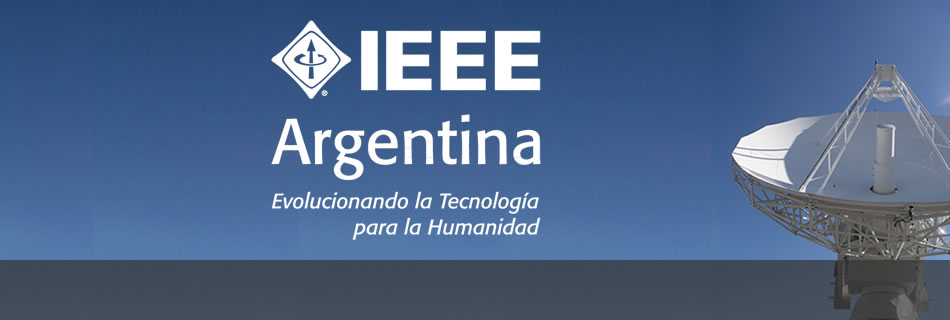Noticias y Actividades
Publicado el 20/03/2012
 IEEE AR BTS. APS, EMCS - Conferencia 'Who Is the Father of Electrical Engineering?’
IEEE AR BTS. APS, EMCS - Conferencia 'Who Is the Father of Electrical Engineering?’
Dr. Tapan K. Sarkar - 14 de mayo de 2012, en la FIUBA, Buenos Aires
Los Capítulos Argentinos de las Sociedades IEEE BTS Broadcast Technology y conjunto APS Antennas and Propagation y EMCS Electromagnetic Compatibility, junto con la Facultad de Ingeniería de la UBA invitan a participar de la Conferencia 'Who Is the Father of Electrical Engineering?’ que dictará el Dr. Tapan K. Sarkar, IEEE Fellow y Disertante Distinguido, durante su visita a la Argentina y según se detalla a continuación.
Conferencia 'Who Is the Father of Electrical Engineering?’
* Fecha y hora: Lunes 14 de mayo de 2012, de 11:00 a 13:00
* Lugar: FIUBA, Facultad de Ingeniería de la Universidad de Buenos Aires
Paseo Colón 850, Buenos Aires (Aula L1)
* Inscripción
Esta actividad es de acceso libre y gratuito.
Agradeceremos inscripción previa, completando el formulario disponible en
http://www.ieee.org.ar/sistemainscripciones/InscripcionSolicitud.asp?idevento=98
Alternativamente, por e-mail a sec.argentina@ieee.org citando 'Conferencia Sarkar EE’, un teléfono de contacto y si es o no socio IEEE, o por teléfono a IEEE / CICOMRA (011) 4325 8839.
Abstract
According to Sir James Jeans: In his hands electricity first became a mathematically exact science and the same might be said of other larger parts of Physics. He did develop almost all aspects of Electrical Engineering.
To start with, as Sir Ambrose Fleming pointed out, he provided a general methodology for the solution of Kirchoff’s laws as a ratio of two determinants.
He showed how a circuit containing both capacitance and inductance would respond when connected to generators containing alternating currents of different frequencies.
He developed the phenomenon of electrical resonance.
He showed that between any four colors an equation can be found, and this was confirmed by experiments.
Secondly, from two equations containing different colors a third may be obtained.
A graphical method can be described, by which after fixing arbitrarily the position of three standard colors that of any other color can be obtained by experiments.
Finally, the effect of red and green glasses on the color-blind was presented, and a pair of spectacles having one eye red and the other green was proposed by him as assistance to detect doubtful colors.
He was the first to show that in color blind people, their eyes are sensitive only to two colors and not to three as in normal eyes. Typically, they are not sensitive to red.
He perfected the ophthalmoscope to look into the retina.
At the point of the retina where it is intersected by the axis of the eye there is a yellow spot, called the macula. The macular degeneration of the eye affects the quality of vision and is the leading cause of blindness in people over 55 years old. Today, the extent of macular degeneration of the retina is characterized by his yellow spot test.
He also developed the fish eye lens to look into the retina with little trauma.
He provided a methodology for generating any color represented by a point inside a triangle whose vertices represented the three primary colors that he chose as red, green and blue.
He took the first color photograph. The experimental set up was to take three pictures separately using different colors and then project the superposed pictures to generate the world’s first color photograph. Today, color television works on this principle, but his name is rarely mentioned.
He wrote the first paper on control theory showed for the first time that for stability the characteristic equation of the linear differential equation has to have all its roots with negative real parts.
He not only introduced the first statistical law into physics but also introduced the concept of ensemble averaging which is an indispensable tool in communication theory and signal processing.
He also did other significant works including introducing the concept of relativity which made Albert Einstein remark: One scientific epoch ended and another began with him –, and, From a long view of the history of mankind – seen from, say, ten thousand years from now – there can be little doubt that the most significant event of the nineteenth century will be judged as his discovery of the …… – Richard Feynman.
He always delivered scientific lectures for the common people using models. He also was very prolific in writing limericks, as we will see.
Yet, very few electrical engineers know who this person is and his contributions!
Orador: Tapan K. Sarkar
 Tapan K. Sarkar received the B.Tech. degree from the Indian Institute of Technology, Kharagpur, in 1969, the M.Sc.E. degree from the University of New Brunswick, Fredericton, NB, Canada, in 1971, and the M.S. and Ph.D. degrees from Syracuse University, Syracuse, NY, in 1975.
Tapan K. Sarkar received the B.Tech. degree from the Indian Institute of Technology, Kharagpur, in 1969, the M.Sc.E. degree from the University of New Brunswick, Fredericton, NB, Canada, in 1971, and the M.S. and Ph.D. degrees from Syracuse University, Syracuse, NY, in 1975.
From 1975 to 1976, he was with the TACO Division of the General Instruments Corporation.
He was with the Rochester Institute of Technology, Rochester, NY, from 1976 to 1985.
He was a Research Fellow at the Gordon McKay Laboratory, Harvard University, Cambridge, MA, from 1977 to 1978.
He is now a Professor in the Department of Electrical and Computer Engineering, Syracuse University.
His current research interests deal with numerical solutions of operator equations arising in electromagnetics and signal processing with application to system design.
He obtained one of the “best solution” awards in May 1977 at the Rome Air Development Center (RADC) Spectral Estimation Workshop.
He received the Best Paper Award of the IEEE Transactions on Electromagnetic Compatibility in 1979 and in the 1997 National Radar Conference.
He has authored or coauthored more than 300 journal articles and numerous conference papers and 32 chapters in books and fifteen books, including his most recent ones, Iterative and Self Adaptive Finite-Elements in Electromagnetic Modeling (Boston, MA: Artech House, 1998), Wavelet Applications in Electromagnetics and Signal Processing (Boston, MA: Artech House, 2002), Smart Antennas (IEEE Press and John Wiley & Sons, 2003), History of Wireless (IEEE Press and John Wiley & Sons, 2005), Physics of Multiantenna Systems and Broadband Adaptive Processing (John Wiley & Sons, 2007), Parallel Solution of Integral Equation-Based EM Problems in the Frequency Domain (IEEE Press and John Wiley & Sons, 2009), and Time and Frequency Domain Solutions of EM Problems Using Integral Equations and a Hybrid Methodology (IEEE Press and John Wiley & Sons, 2010).
Dr. Sarkar is a Registered Professional Engineer in the State of New York.
He received the College of Engineering Research Award in 1996 and the Chancellor’s Citation for Excellence in Research in 1998 at Syracuse University.
He was an Associate Editor for feature articles of the IEEE Antennas and Propagation Society Newsletter (1986-1988), Associate Editor for the IEEE Transactions on Electromagnetic Compatibility (1986-1989), Chairman of the Inter-commission Working Group of International URSI on Time Domain Metrology (1990–1996), distinguished lecturer for the IEEE Antennas and Propagation Society from (2000-2003) and (2011-present), Member of Antennas and Propagation Society ADCOM (2004-2007), on the board of directors of ACES (2000-2006), vice president of the Applied Computational Electromagnetics Society (ACES), and a member of the IEEE Electromagnetics Award board (2004-2007), and an associate editor for the IEEE Transactions on Antennas and Propagation (2004-2010).
He is also on the editorial board of Digital Signal Processing – A Review Journal, Journal of Electromagnetic Waves and Applications and Microwave and Optical Technology Letters.
He is the chair of the International Conference Technical Committee of IEEE Microwave Theory and Techniques Society # 1 on Field Theory and Guided Waves. He is listed by ISI among the top 250 of most referenced authors in this field.
He is an IEEE Fellow since 1992.
He received Docteur Honoris Causa both from Universite Blaise Pascal, Clermont Ferrand, France in 1998 and from Politechnic University of Madrid, Madrid, Spain in 2004.
He received the medal of the friend of the city of Clermont Ferrand, France, in 2000.
http://www.lcs.syr.edu/faculty/sarkar
*** Para información sobre más actividades del Dr. Tapan K. Sarkar en Buenos Aires ver aqui
Destacados











